The CSCS mock test for Operatives, also known as the CITB Health, Safety and Environment Test for Operatives, is made up of 50 multiple-choice questions. You have 45 minutes to complete the test. The pass mark is 45/50. Once you’re ready to start the test, click Begin Test.
Mock Test for Operatives

- Answered
- Flagged
You have 45 minutes to answer 50 multiple choice Mock Test questions for Operatives and Specialists. You need to answer at least 45 out of 50 questions correctly to pass. Answers may be reviewed after each question or at the end of the test. Good luck!
Do you wish to proceed?
1573 votes - average 4.4 out of 5
CSCS Test for Operatives and Specialists
Below are several free CSCS mock tests for operatives and specialists.
There are more than 1000 practice questions for Operatives and Specialists in these mock tests. All tests last for 45 minutes and have 50 questions which have been randomly selected from 16 categories.
Operatives Tests by Category
Specialist Activities
Below are several free mock tests for specialists.
If you are preparing for a specialist test, you also need to study the appropriate specialist activity, from those listed below. There are more than 500 specialists questions.
CSCS Mock Test for Operatives Practice Questions (Printer-Friendly)
B All accreditation will be void
C UK health and safety regulations MAY be reviewed and changed
D You WILL be asked to learn new safety signage
Explanation: UK regulations do not change by default following Brexit - however, some regulations may be taken into review.
B To ensure all participants understand how to use activity-specific equipment
C To informally check in on employee wellbeing without escalation
D To regularly assess the quality of operating equipment
Explanation: A toolbox talk is a session briefing workers on health and safety aspects of a particular task.
B It provides specific details of laws broken by an employer, and a date by which improvements must be made
C It suggests general improvements on how an employer or employee can improve safety standards
D It suggests general recommendations on how an employer can improve safety standards in the workplace
Explanation: Improvement notices can be issued against an employer or individual employee, and detail both legally required improvements, along with the date by which such improvements must be made.
B TRUE - they can bill hourly charges for this additional time
Explanation: The Health and Safety Executive is permitted to bill for additional hours required in an investigation.
B No, unless you have a written request from your doctor
C Yes
D Yes, if a lawyer acting on your behalf files a formal request
Explanation: Individuals are entitled to a copy of information held about them in the accident book.
B Larger dust particles
Explanation: Smaller dust particles can lodge themselves more deeply in your body, and are more hazardous.
B Mahogany dust
C Medium density fibreboard
D Softwood dust
Explanation: Softwood dust can cause sensitisation.
B Get more distance by joining up a number of leads
C Talk to your supervisor about moving the transformer
D Try to move the transformer yourself
Explanation: Do not link up several extension leads if your cable does not reach the transformer. Talk to your supervisor about moving the transformer nearer to you.
B At the welfare services
C Away from where the work is being done
D Where the work is being done
Explanation: Petrol must not be stored at the work location.

B Carpal tunnel syndrome
C Dermatitis
D HAVS
Explanation: This diagram illustrates symptoms of HAVS.
B Slippery gloves - they reduce the transmission of vibrations to your body
C Warm gloves - cold hands are more susceptible to vibration damage
D You should never wear gloves whilst operating tools
Explanation: "Anti-vibration" gloves are not recommended. They usually have minimal or no effect, and may increase damage; keeping hands warm provides better protection.
B Using materials from natural sources
C Using materials that blend in with natural surroundings
D Using materials that have a low impact on the environment
E Using materials with good resource efficiency
Explanation: Resource-efficient materials with low environmental impact will help to make a building sustainable.
B Disposing of plasterboard in the biodegradable waste bin
C Excessive noise
D Playing music in the canteen
E Sandwich wrappers blowing off-site
Explanation: Pollution includes accidental spreading of waste, incorrect waste disposal, and things like excessive noise, light, and vibration.
B Bucket
C Drip tray
D Funnel
E Plant nappy
Explanation: To help prevent over-filling, you can use special nozzles and funnels where necessary.
B Red, Red 'C', Blue
C Red, Red 'C', yellow
D Red, Yellow, White
Explanation: Red, red 'C', and blue are the three drain colours.
B Mastics
C Silty water
D Tubing from fluorescent lights
Explanation: Silty water is not a hazardous substance - it is a pollutant.
B Ensure the excavation is manned at all times
C Erect barriers around the excavation
D Install a motion-sensor alarm system around the perimeter
Explanation: Lighting and barriers are both recommended ways to ensure the public are not put at risk by excavations.
B Work will not begin until the service is disconnected
C You will be able to tell it is live when you look at it
D You will be informed, and safety measures will be put in place
Explanation: Work may continue if a service cannot be disconnected - but safety measures must be put in place.
B A tiled roof
C A wired glass roof
D An asbestos sheet roof
Explanation: Many sorts of roofing can create fragile surfaces.
B That the platform is clean
C That the wheels are locked
D That the wheels are properly oiled
Explanation: The wheels must be locked before work can safely begin.
B Do not use it and report the fault to your supervisor
C Report it in the accident book
D Secure the rung and continue work if it is safe to do so
Explanation: Equipment defects must always be reported.
B So other workers do not enter the area
C To ensure nothing is nearby to block light
D To reduce distractions to workers on the tower
E To reduce the harm to workers in case they fall
Explanation: A safety zone ensures nobody enters the hazardous work area around the tower.
B To keep members of the public out
C To stop machinery, equipment, and other items going in
D To stop people going in
Explanation: Exclusion zones stop on-site workers, and anything else, entering the dangerous area around a power line.
B Clothing and equipment designed to serve as hazard protection
C Ear protectors used for noisy areas
D Protective casings designed for hand-held tools
Explanation: PPE is a cover-all term applied to any clothing or equipment designed to shield you from hazards.
B Nothing specific - its condition is the responsibility of site management
C Repair it when necessary
D Take it with you at the end of shift to ensure it does not get lost
Explanation: You should ensure you check your PPE regularly for faults, and keep it clean and hygienic.
B Fit it over the hood of a jumper
C Fit it snugly around a warm hat
D The helmet must not be adapted - so ensure you are wearing warm clothes
Explanation: Proprietary cold-weather linings can be obtained for safety helmets. Do not wear them over hats or hoods, as this will affect their efficacy.
B It sits snugly on your head
C It stays in place when you bow your head to the floor
D There is room to insert one finger between your head and the helmet
Explanation: A properly fitted helmet will sit snugly on your head.
B They do not light well in smoky rooms, creating an evacuation risk
C They may overheat, creating an ignition risk
D They will explode in case of fire, creating an injury risk
Explanation: Lights, especially halogen lights, may become ignition risks if they overheat.
B Yes, if it is used only for burning welfare waste
C Yes, only if it has been cleared with the site management
D Yes, only if the site has a permit to do so
Explanation: Bonfires are only allowed if the site has a permit.
B The valve is rusting
C They are being stored at too low a temperature
D They are leaking
Explanation: Frost around the valve indicates that an LPG cylinder is leaking.
B HSE regulations
C Hazardous Substances Act
D Health and Safety at Work Act
Explanation: Control of Substances Hazardous to Health (COSHH) regulations cover your employer's legal obligations.
B They will be available on request at welfare facilities
C They will be displayed on site along with emergency information
D You will be asked to add them to your phone contacts during your induction
Explanation: Emergency contacts must be displayed along with emergency information and numbers on-site.
B TRUE
Explanation: It is your employer's responsibility to provide first aiders.
B The damage can be treated, but it may take weeks
C The damage may be untreatable
D Your employer will be responsible for treating this condition with on-site medical staff
Explanation: Where health problems develop as a result of exposure over a long period of time, the damage may be irreversible.
B Chemical burns
C Fume inhalation
D Neurological damage
Explanation: Wet cement can cause chemical burns.
B Construction workers are at close quarters with one another, so allergic dermatitis will spread quickly between colleagues
C It is usually not covered by work health insurance policies, meaning costly treatment will have to be funded by individuals
D You may develop extreme sensitivities to particular substances, rendering you unable to work with them. This could be career-ending
Explanation: Allergic dermatitis can cause the sufferer to develop acute sensitivity to particular substances. If you are unable to work with this substance, you may have to change careers.
B Pizza knee describes irritant contact dermatitis on the knee
C Pizza knee describes patchy discolouration on the knee from kneeling too long
D Pizza knee is when a knee has been heavily bruised
Explanation: Pizza knee is an informal term for irritant contact dermatitis
B Mental health problems are treated with medication
C There will be clear precursors to mental health problems
D You can have mental health problems even if there is no clear cause
Explanation: Mental health problems often come up without any clear cause; there are many ways they can be resolved or treated.
B Leave the granules out for up to 72 hours, then sweep them into the waste bin
C Once finished, put the granules in the waste bin in a sealed special waste bag
D Once finished, seal the granules in a waste bag to be disposed of by specialists
Explanation: Absorption granules must be safely disposed of by a specialist.
B They might appoint a First Aider
C They might insist on longer shifts to improve morale
D They might share mental health records with colleagues
Explanation: Your employer might appoint a Mental Health First Aider.
B Can the truck be moved closer?
C Can workers avoid moving this material manually?
D Is this the most cost-efficient strategy?
E Will this create insurance liability issues?
Explanation: Where possible, reduce the distance a load must be moved - or eliminate the need for manual handling entirely.
B Their availability
C Their pay grade
D Their race
E Their stature
Explanation: The correct workers must be chosen for manual handling. This must take into account their physical suitability for the task.
B Just one person
C Someone who is not lifting
D Whoever is tallest
Explanation: One person should lead and clearly instruct during a team lift.
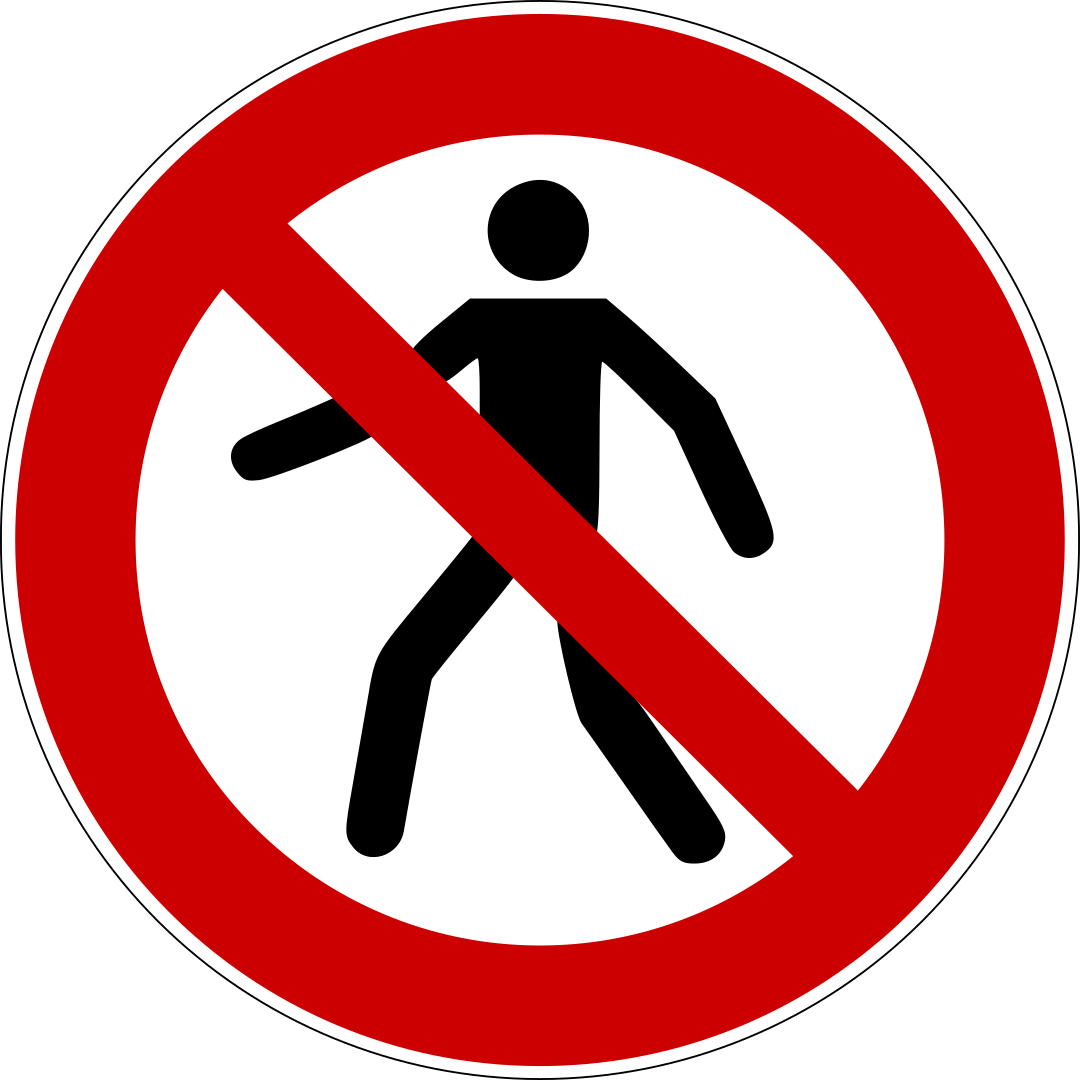
B No entry
C No public access
D You must not use the area as a thoroughfare
Explanation: This sign indicates areas which are not thoroughfares.
B A damage examination, at the end of the operation
C A functional examination, annually
D A thorough examination, periodically
Explanation: Thorough, periodic examinations must take place as well as regular inspections.
B An inspection is thorough, an examination is not
C An inspection will produce a report, an examination will not
D They are the same thing
Explanation: Examinations, unlike inspections, must produce a written report.
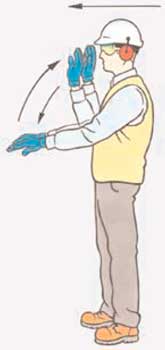
B
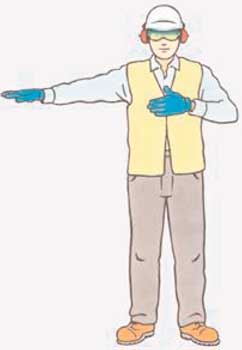
C
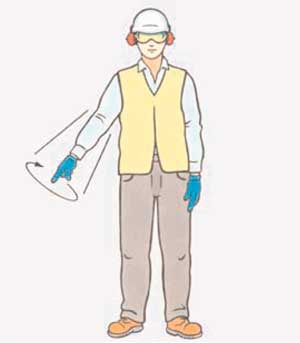
D
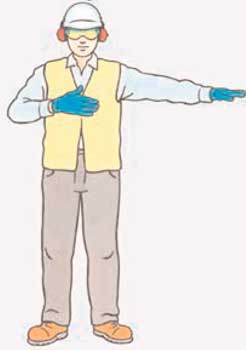

Explanation: This sign signals a left turn.
B They are in zone 2
C They can be seen by passers by
D They can be seen by the operator
E They can see the load
Explanation: A signaller must be able to see the load, and be seen by the operator.
B Inform your supervisor that you are not trained to use the truck
C Report your supervisor to the site manager
D Use the truck to the best of our abilities
Explanation: Always inform your supervisor if you are not trained for a task you have been assigned.
B The vehicle is overloaded and overheats
C The vehicle overturns
D The vehicle reverses into a pedestrian
Explanation: Overturning is a common accident when using dumpers.






























